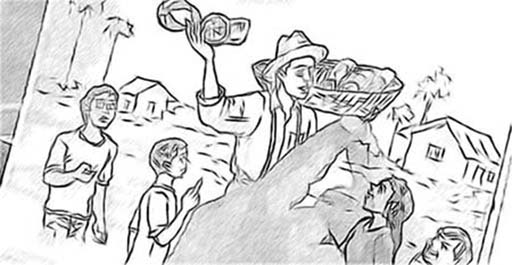2 Pictures and words
In Case Study 1, Ms Sheela looked for ways to get the most out of her textbook, picking up on words or sentences that she and the students can continue to use when the language lesson is over. In the next case study, a teacher improvises on a textbook topic, using pictures to develop students’ English speaking and vocabulary.
Case Study 2: Mr Aman uses pictures to develop language
Mr Aman used Class IV students’ existing knowledge about their family to teach English.
Unit 1 in the textbook was about a child and her family. I showed the students the ‘family’ words and pictures in the textbook. We said the words aloud and I wrote them out on the board.
Then I told them to draw pictures of their own father, mother, grandfather, grandmother and so on, and then to label the pictures in English. They began to ask me questions such as:
- ‘Does English not have different names for the father’s mother and the mother’s mother?’
- ‘Is the word for elder sister the same as for younger sister?’
I taught them to say ‘elder sister’ and ‘younger sister’, and ‘mother’s mother’ and ‘father’s mother’, even though these expressions are not in the textbook. Then I demonstrated how to form sentences orally, using the students’ drawings as examples:
This is my mother. This is my elder sister.
This is Rajiv’s father.
This is Amrita’s grandmother, her mother’s mother.
We practised saying these sentences aloud together. It was good practise for my own English.
Later in the week, I extended the lesson. First I had students circle the ‘he’ and ‘she’ words in the textbook. Then I demonstrated aloud, using their pictures, how to add to their first sentences using new vocabulary:
This is my mother. She is pretty.
This is my elder sister. She is tall.
This is my brother. He is crying.
This is Amrita’s grandmother. She is nice.
This is Sushant’s father. He is a farmer.
I put the students in pairs and had them practise sentences with each other, showing their drawings to demonstrate their words. As they did this, I could observe and make notes on their confidence and skills.
Some of my students come from the local orphanage and have no family. I asked them to draw pictures of their friends or other people they know in the village. I did this carefully, without singling them out and making them feel unduly self-conscious. To involve the less confident students, I pointed to their pictures and asked ‘Is this your father? Is this your sister? Is this your friend? Is this the farmer?’ They answered ‘yes’ or ‘no’, or just shook their head, so I could assess their understanding.
Pause for thought
|
Video: Using pair work |
Activity 2: Using pictures
Using Case Study 2 as an example, plan and teach a lesson where students use pictures to practise English.

Take a textbook lesson. The lesson might be about family, animals, food, travel or the environment. It can be a lesson you have already taught, or a new lesson. You may teach this over several lessons.
- Explain the topic, showing students the pictures and practising the vocabulary together.
- Have students make their own pictures and label their pictures in English.
- Teach them to use simple sentences in English, based on their pictures.
How will you assess the students? Will you listen to them as they work? Or will you have them explain their work to you, or perform to the class?
What will you do for students who need additional support? Some students may need extra time to complete the task, or help to overcome shyness to speak. Your plan should be flexible to accommodate these needs. If you have a large or multi-grade class, direct the able or older students to help the younger ones. Organise groups so that you can focus on students who need your attention.
Video: Using groupwork |
In Case Study 2, Mr Aman improvised from the textbook. In the next case study, the teacher also improvises to use new words in English with her students.
Case Study 3: Ms Trishna and her students use new words
What English words do your students already know, and what English words would they like to learn? Ms Trishna, a Class III teacher in Lucknow, found out.
I was teaching a textbook lesson about ‘A Busy Road’. Before I wrote vocabulary about this topic on the board, I asked students for words they already knew in English. They were giving me words like ‘traffic’, ‘traffic police’, ‘policeman’, ‘cars’, ‘bicycle’, ‘traffic jam’, ‘rush’ and ‘zebra crossing’.
Then one student said ‘shor’ and asked, ‘Ma’am, what is “shor” in English?’ I added a new English word to the class vocabulary: ‘noise’. I tried to reinforce this new word in English by using it at different times of the school day, and in different forms, for example, I would say:
- ‘Can you hear the noise from the street?’
- ‘What a lot of noise!’
- ‘You are very noisy!’
And I also tried to use the opposite word, for example:
- ‘When you are quiet, you can go outside.’
Pause for thought
|
1 Using the textbook
